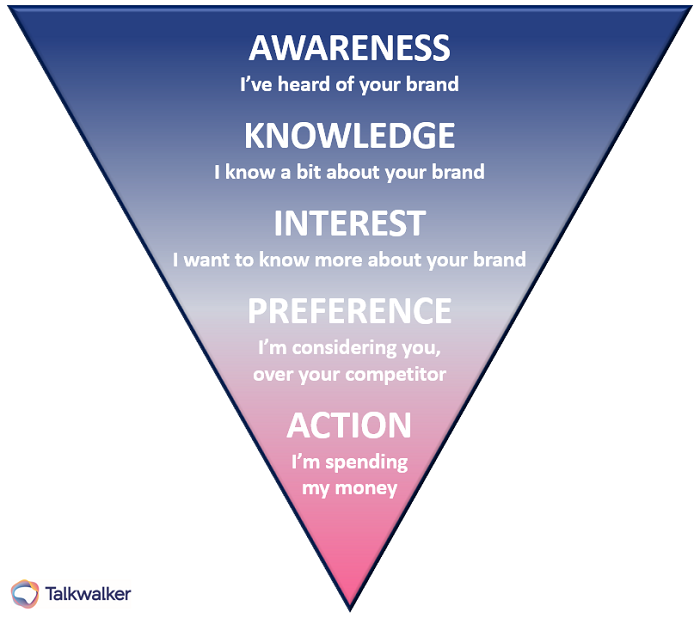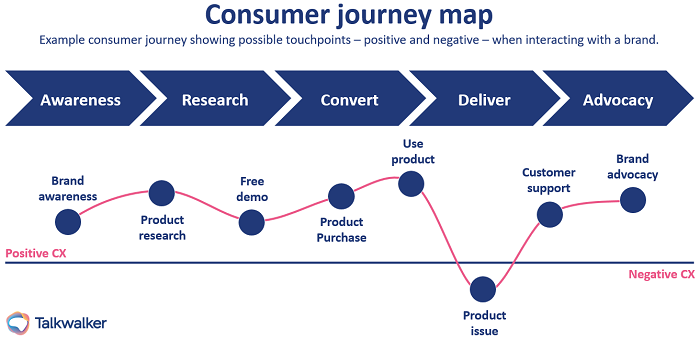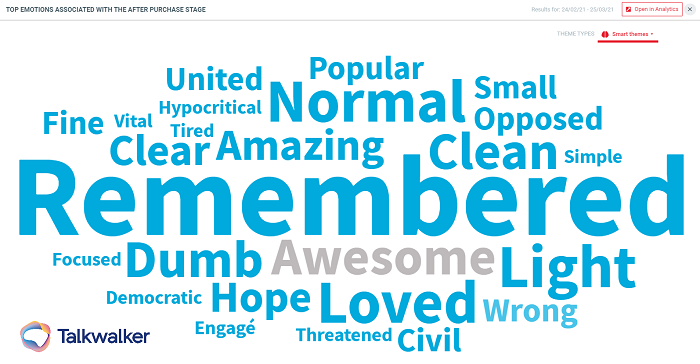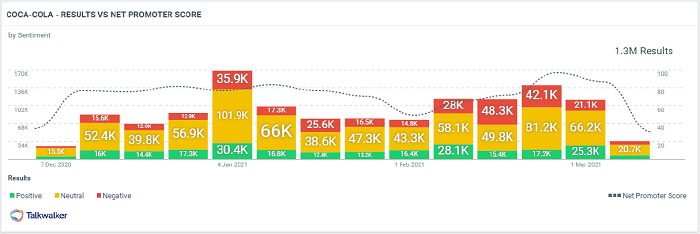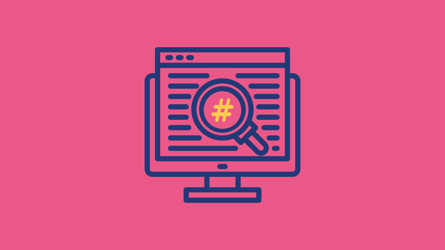Consumer journey maps encourage collaboration across your organization – aligning all your internal teams with the same goal of attracting and retaining customers, resulting in a consumer-centric business approach
The result is not only a streamlined business process, but also a great customer experience, and increased revenue.
But why are consumer journey maps so effective?
Because they produce targeted and personalized engagement with consumers.
The aim is to break down the consumer journey into key steps and deliver relevant content on appropriate channels at each milestone. So, instead of finding generic content, the user is targeted with content that’s perfect for them, wherever they are in the buying process.
For example, informative blogs when they’re still researching, or videos of products once they’re aware of what they need. It could even include thank you emails for payment, upsell opportunities following a positive review, or a “sorry to see you go, is there anything we can do?” email if they leave.
In this guide, the analytics experts at Talkwalker explain exactly how a consumer journey works and how to create one to drive more engaging user experiences.
Table of contents
- What's a consumer journey map?
- Benefits of mapping the consumer journey
- 4 stages of a digital consumer journey
- Team benefits of consumer journey analytics
- What is consumer journey measurement?
- Why measure consumer journeys?
- How to measure a consumer journey
- Consumer journey metrics to measure success
- • Drive consumers towards their goals with Talkwalker
Consumer journey map - awareness, research, engage, convert, deliver, advocacy.
What’s a consumer journey map?
A consumer journey map is a visualization of a potential customer’s experiences and interactions with your brand – and their feelings and perceptions at each stage.
A consumer journey map is a visualization that shows you how a consumer converts into a customer. Demonstrating their initial interaction with your brand, and the steps they take to purchase.
Your map can represent at a macro level – such as examining a long-term, retained relationship with a loyal consumer – or at a micro level, looking at a single step in the consumer journey, such as signing up for a free demo, making a purchase, or raising a support ticket.
Mapping the journey includes every interaction a consumer has with your brand. From awareness, interest, and desire, to action, and if you’re lucky, advocacy.
These steps are taken for offline and online purchases, but in e-commerce, the journey includes digital touchpoints – such as a consumer searching on Google, visiting your website, following your brand on social media, and more, on apps, smartphones, and desktops.
Example of a consumer journey with touchpoints offering a positive CX and negative CX, when interacting with a brand.
Brands engage with consumers across multiple channels throughout their journey – each with several touchpoints designed to push the consumer along their journey towards their goal.
Below are some of the key touchpoints brands may analyze on a consumer journey…
Awareness, research, engage touchpoints
• Click an ad• Find the website via organic search
• View multiple web pages
• Click on links from other sites
• Start chat
• Download gated content from landing pages
• Watch ‘how to’ videos
• Read blog posts
• Receive email nurturing campaigns
• Email/phone call with sales team
• Sign up for a free demo
Conversion touchpoints
- Create an account
- Set up account and profile
- Receive onboarding
- Watch training videos
- Read documentation
- Raise customer support tickets
- Make payment
Delivery & advocacy touchpoints
- Use product or service
- Use advanced features
- Submit support tickets
- Recommend to peers
- Upgrade to higher payment program
- Post positive reviews
- Become a brand advocate
Your consumer journey map will help you understand consumers’ experiences and needs, enabling you to create messaging that’s targeted and personalized.
Benefits of mapping the consumer journey
The consumer journey is way more complicated than it used to be. Mapping it will help you understand and share all the interactions that happen between a consumer and your brand. This can only lead to positive business outcomes...
Targeted marketing
The consumer journey is much more complex than it used to be – with an increasing number of digital touchpoints, and more intelligent platforms for tracking them.
Mapping is important in helping you understand and share all the interactions that happen between a consumer and your brand. Some of the key benefits of consumer journey mapping include:
Targeted marketing
If your marketing team understands the journey consumers are taking, they can tailor their messaging for each step – walking consumers through each stage of the customer journey with personalized content.
As a result, you'll increase click-through and conversion rates, improving the ROI of your marketing investments.
Keep your entire company updated
The marketing team has one voice and message, the sales team another, and account managers different still.
It's not untypical in a large business that messaging, tone of voice, and language can differ between teams.
A consumer journey map, shared with the entire company, keeps everyone talking with one voice – singing from the same song sheet.
So, you'll be able to build a customer-centric culture across your organization, with your brand feeling familiar and reliable across every touchpoint.
Move conversions & increased retention
Mapping every single step of the consumer journey means you can create a marketing strategy that addresses and meets every goal.
A comprehensive mapping of the consumer journey will highlight any sticking points, so you can improve. For example, you'll be able to find where consumers abandon their journey, or where customers churn.
Constant monitoring of the journey is crucial for a good customer experience.
4 stages of a digital consumer journey
A well-mapped consumer journey ensures that every action leads to a positive outcome.
Each stage of the consumer journey considers what the consumer is thinking and feeling – so, every interaction with your brand meets their needs, and gently nudges them along their journey towards their goal.
For the modern consumer, this is typically a four-step digital journey, consisting of the following key stages:
Awareness
In the first stage, a consumer wants something, but may not realize they need your product yet. They haven't started to look, but will pay attention to an ad.
We've already proved that consumers favor brands they love, or they're familiar with. Hence, your brand needs to be out there building awareness.
At this early stage in the digital consumer journey, you need to grab eyeballs – showering them with social media posts, paid ads, blog posts promoting your product, and more, to stay top of mind.
Consideration
At this stage, the consumer recognizes the need for a product and starts to research online.
According to research, 56% of consumers start their product research on Amazon, with 42% beginning on Google – suggesting brands must diversify with relevant content to meet consumers exactly where they’re searching.
Remember, consumers trust their peers when it comes to choosing a brand, so share customer reviews. User-generated content is invaluable, as well as client testimonials, customer case studies, comparisons, free demos, and influencer recommendations.
Conversion
By this stage, the consumer has interacted with your brand and is aware of your product. So, it’s time to give them a call to action.
This stage of the digital journey relies on an exceptional customer experience. You're asking the consumer to hand over their hard-earned cash, so you must provide a seamless path to purchase – because there's still time for them to abandon their cart.
You want the consumer to convert, so ensure your brand's checkout page is easy to understand and user-friendly.
Advocacy
The consumer has now parted with their cash, but their journey doesn't end there. You must deliver on their expectations. Engagement has to continue.
If you give the consumer a superior experience, the chances are they'll share their experience with others. This is where the user-generated content that proved so valuable in the conversion stage is created.
Your happy customer will post reviews, ratings, and positive social media posts boasting about their new purchase.
A happy customer is also receptive to complementary products, up-sells, and cross-sells. A happy customer has a long lifetime value.
Talkwalker’s consumer intelligence platform will identify the emotions expressed after the purchase stage in the consumer journey.
Ready to begin consumer journey mapping – turning user data into actionable insights to improve the customer experience?
Talkwalker’s Social Listening tool gives you access to the authentic online conversations taking place around your brand at every stage in the consumer journey.
Understand your consumer’s pain points and challenges – as well as what made their positive experiences – and improve their interactions with your brand across every touchpoint today.
Team benefits of consumer journey analytics
Does every team in your company have access to consumer journey insights – to know exactly how consumers are behaving?
Rolling out a consumer journey analytics strategy ensures every team is equipped with this consumer behavior data and working in alignment, to streamline the consumer journey and provide the best customer experience.
But who exactly does this include? And why?
Below are some of the teams that will reap the rewards of consumer journey analytics:
Marketing
Imagine if you knew how to engage with a consumer at every point in their journey. You could personalize consumer interactions at every stage of their journey – showing that you know them, their needs, and their pain points.
Targeted marketing campaigns like this are proven to be more effective. Using consumer journey analytics enables your team to segment your audience, by demographics, location, and industry type, as well as by behavior.
Maybe one of your channels provides a better user experience. A faster route to purchase. A more user-friendly language.
Having these consumer insights means you can improve your digital channels. Your marketing, customer experience, and customer service teams can streamline the journey. Increasing customer satisfaction, and potentially reducing costs.
Personalizing your interactions with your consumers will inevitably lead to increased customer satisfaction, up-sell and cross-sell opportunities, reduced churn, and increased loyalty.
Customer experience
Proving the impact consumer behavior has on business results has always been difficult.
And with the pandemic causing consumer and customer behavior to change so dramatically, the problem of measuring the impact is exacerbated.
But your customer experience (CX) team still needs to prove ROI, otherwise justifying next year’s budget will be a struggle.
Consumer journey analytics will help your CX team measure and understand the customer journey. The team will be able to monitor and analyze throughout the journey, from:
- The route a consumer takes toward their goal
- If a consumer is going to achieve their goal
- Whether the CX is a help or a hindrance in a consumer reaching their goal
So, your CX team will be able to identify which journeys are failing, or which segments of a journey are proving to be stumbling blocks for consumers – as well as the journeys that are driving revenue.
With these insights, your CX team can improve and have a rock-solid case for next year’s budget.
Customer support
If your customer support team knows the goals and journey a consumer has taken to reach them, the support provided will be targeted and more effective. And improvements can be made to customer service that’ll lead to a reduction in call volume.
The result? Fewer calls, less time and effort, increased customer satisfaction, and reduced costs. Ultimately, your customer service team will have more time to spend on high-value tasks.
But how do you find this information?
There are plenty of consumer journey analytics metrics that prove valuable for your customer service team – including insights from conversations, text analytics and speech analytics, customer feedback, and sentiment analysis.
Does every team in your company know how consumers are behaving? Every team?
Having a consumer journey analytics strategy will ensure that every team in your organization has access to real-time insights into consumer behavior. A full-exposure approach means that your teams are working in alignment. Collaborating on how to streamline the consumer journey and provide the best customer experience.
Here’s some of the teams that’ll reap the rewards of consumer journey analytics…
What’s consumer journey measurement?
Customer journey measurement refers to how businesses analyze and assess different user metrics at each stage in the buying funnel.
Each stage may have a different metric – for example, website sessions, social media engagement, or even form completions – but they all help reveal which areas of the customer journey are working and which are underperforming.
Measuring your customer journey therefore allows you to evaluate and improve the customer experience.
Effective customer journey measurement is only achieved once you’ve determined the customer and business goal for each journey – and whether or not the CX works towards them reaching their goal.
All these elements will help you measure current and future performance. You’ll also realize how customer behavior affects customer experience and business outcomes.
Why measure consumer journeys?
Imagine a consumer buys an air fryer that stops working after just a few uses. They contact the brand on social media to no reply. So, they ring customer service but the representative isn’t able to solve the problem.
Eventually, they are passed to the technical team, which helps solve the problem.
In this scenario, the brand resolves the customer’s issue – but not before delivering a poor customer experience, with the consumer having to reach out multiple times.
How does your company measure a customer experience like this? Often this interaction will be measured and reported on in a way that doesn’t paint an accurate picture.
The social media manager may report the social media engagement, while customer support records an issue being raised and transferred, and IT even reports a successful resolution. But the customer had a negative experience.
While your company as a whole is tracking, it’s recording three separate journeys. Whereas for the consumer, it’s a single, complicated journey.
Measuring the consumer journey from a single source enables your brand to improve the CX – creating a streamlined journey for the consumer to reach their goal.
A consumer journey map is only beneficial to your business if it provides actionable insights. Using customer journey analytics, you can ensure your map works in real-time, as well as make sure it is measurable and reflects how consumer behavior influences your brand KPIs.
So, how can you transform your reporting to achieve this accurate CX journey?
Measure all consumer journeys
Your team has drawn up several example journey maps, covering the most common routes taken by consumers to reach their goal.
But if there are 5,000 consumers traveling towards their goals, that’s 5,000 potential journeys.
While the end goal on a consumer journey map is, typically, a purchase, consumers don’t always follow the route you’ve predicted.
For example, if one customer starts a journey because they have a problem with a recently purchased product, their goal will be to resolve the problem. But what if, during this process, the customer support agent suggests another product – and the consumer buys?
The journey map did not predict the customer’s behavior.
In the modern digital world, consumers are now able to follow a journey that moves on and offline – a consideration your journey map could miss if it’s one-size-fits-all.
Consumer journey analytics predicts more routes that the user could have taken, across multiple channels. By reporting on all possible metrics – customer satisfaction, up-sell, cross-sell, and more – you can identify these relevant journeys.
Machine learning-enabled consumer journey analytics track patterns to find sticking points in journeys and can predict consumer behavior in real time. So, you have the insights needed to engage most effectively.
Find real consumer journeys
Consumer journey maps cannot be created on guesswork or assumed paths to purchase. They must be based on real consumer data – from various sources – revealing the authentic journeys that consumers take.
Consumer journey analytics collects data from your website, call center logs, point of sale system, apps, customer support tickets, emails, and more.
Once all this consumer data is collected, it segments the consumers into buyer personas performing the same interactions with your brand and revealing all the different journeys they take.
Collect and analyze data from your call center logs to have a clearer picture of your customers across different channels.
Including data from consumer journey analytics ensures your journey maps are actionable.
Create personalised consumer journeys
Consumers demand a personalized experience, expecting brands to know their preferences and remember how they interacted with your company.
And this puts consumers in the driving seat, as they know that they can drop your brand for a competitor at any moment.
So, it’s crucial you provide a top-notch customer experience, throughout the consumer journey.
Analyzing consumer journeys in real time, and collecting consumer insights from recent interactions across multiple channels, helps you provide a personalized experience for each consumer.
Not only will you be able to catch consumers who are about to abandon their journey, but you can also receive real-time consumer feedback on updates to the customer experience.
How to measure a consumer journey
While there are potentially hundreds of unique consumer journeys possible across your brand’s digital touchpoints, the most effective way to begin your consumer journey mapping process is by choosing several key journeys.
Then, once you’re confident, add more.
This consumer measurement strategy will work across industries – you just need to tailor it to fit your business processes.
Below are the four key steps in bringing your consumer journey maps to life:
1. Decide which journeys to measure
A consumer following a natural journey to become part of your customer base could go in many different directions.
Their journey starts when they realize a need for something. From visiting a landing page and downloading a case study to signing up for a free demo. From requesting a quote to choosing a payment plan. To using your product.
Below is a list of typical consumer journeys, as they move toward their goal:
- Becoming a customer
- Identifying a need
- Researching possible solutions
- Shopping around
- Purchase
- Onboarding to use a product
- Payment process
- Using a product
- Customer support
- Product, service, payment plan update
- Customer waves goodbye
Which journeys work for your business, with regard to how they impact your business goals?
- Is onboarding new customers a priority?
- Is your customer support effective in resolving issues quickly?
- Does your payment process cause cart abandonment?
- Do you need to improve these customer journeys?
When it comes to measuring a journey, include every channel – website, app, social media, and more – in a single journey. How is each channel performing? Are there any issues that you should fix?
2. Confirm your data points
The data you need for journey measurement depends on the journey you choose, and how many channels your business operates on in that journey – such as website, social media, mobile apps, chatbots, and more.
How many ways can a consumer achieve their goal in the journey you want to measure? Which channels could they use?
Consumer journey data captures when a customer interacts. It drives analysis and actions to further optimize a journey.
Suppose you choose to look at the customer support journey. Straight off, there are multiple entry points – including chatbot interactions, raising a ticket on your website, calling customer support on the phone, asking for help on social media, and more.
The consumer journey can visit several teams in your organization, so you’ll need to align with these teams to break down data silos to can collect their data.
3. Determine the steps in a consumer journey
The steps – or milestones – in a consumer journey are taken as the potential customer travels towards reaching their goal. Each step can be taken across a different touchpoint, as each consumer is a unique individual with different behaviors and preferences.
Defining these steps, while challenging, means that you can track a consumer's progress, measure the performance of the journey, and predict the outcome of the journey.
If a consumer changes channel – for example, from social media to a customer support call – the chances are they’ve hit a sticking point in their journey that you need to address. If the consumer bounces out of the journey, it’s vital that you analyze their experience.
Brands that fail to do so risk paying the price, with research showing half of consumers have ended a long-term relationship with a brand after just a single poor experience – and 86 percent admitting they would do so after two to three negative customer experiences.
Some success metrics may include customer satisfaction (CSAT), Net Promoter Score® (NPS®), customer effort score (CES), task completion, and customer lifetime value (CLV).
Simulated consumer intelligence dashboard - Net Promoter Score® showing spikes shadowing online mentions around the beverage brand.
For more inspiration, check out our guide to 19 customer experience metrics that are vital to measuring your consumer journey effectively.
4. Scoring your consumer journeys
Not all journeys are equal – which means you’ll have multiple journey performance scores to demonstrate how consumer journeys are performing.
You’ll need to use a mix of CX metrics, depending on the journey, to understand the consumer experience during their journey, with:
- A streamlined experience towards a goal scoring high, and;
- A goal reached, but following a painful journey, scoring poorly, even though the goal was met.
For example, a consumer raises a ticket because their streaming platform isn’t performing. The goal is to get it fixed. The customer support team eventually fixes the issue and the ticket is closed.
This is the simplified version of the consumer journey – that doesn’t provide the valuable detail needed to learn from the interaction and improve the CX.
In this example, the brand misses the fact the consumer had to chase a response to the ticket. There were several backward and forward emails as the issue went unresolved. The consumer’s comments expressed dissatisfaction, and they requested a refund for all the downtime. But the consumer journey only shows an issue fixed and a ticket closed.
A comprehensive and data-backed journey score will highlight when a journey is failing and find the reasons behind it. Journey scores are also crucial to reporting your results across your entire organization, working towards improving the customer experience.
Talkwalker’s Social Listening tool uses sentiment analysis to reveal consumer insights at every stage of their journey.
Understand exactly where you’re delivering an exceptional customer experience – as well as where you need to focus your marketing, customer service, sales efforts, and more – today.
Consumer journey metrics to measure success
While a consumer journey map will show you all the touchpoints between a consumer and your brand, on and offline, you need more detailed metrics if you're looking to improve your performance.
The metrics you use will depend on your business' journey map, for example:
Awareness
This first stage is where a consumer becomes aware that they need a product and they start researching. Your metrics for this initial stage could include:
- Number of visits to your website
- SEO ranking
- Social media engagement – including likes, shares, comments, impressions, reach
- Video views
- Subscriptions to newsletter, free demo, and other materials
- Conversion rate
Consideration
You'll need to refer to your marketing team’s content strategy for the consideration stage, as this is where you’ll measure engagement with key touchpoints or content.
This may include blog posts, email marketing, videos, social media campaigns, and more.
Depending on your product or service, this stage could involve multiple engagements with the consumer.
Therefore, your metrics will be marketing KPIs, such as:
- Clicks
- Click-through rate (CTR)
- Open rate – OR
- Engagement
- Cost-per-click (CPC)
Conversion
The conversion stage is where a consumer becomes a customer, so, here we're looking at conversion metrics.
But, you'll also need to count cost per lead and cost per conversion, so you understand how much you've spent converting a consumer.
Possible metrics here include:
- Leads
- Conversion rate
- Sales
- Cost per lead (CPL)
- Cost per conversion
Retention
The retention stage is all about keeping existing customers happy and minimizing churn.
Metrics may include:
- Customer loyalty
- Net Promoter Score®
- Customer satisfaction
- User feedback
- Customer support tickets
- Customer lifetime value
Advocacy
If your customers are satisfied, the advocacy stage will see them become brand advocates.
At this stage, you may measure:
- Referrals
- Customer reviews
- Guest posts
- Influencers
Usually on a scale from one to five, customers are asked how satisfied they are. Very satisfied or not satisfied.
Here's Amazon’s rating system...
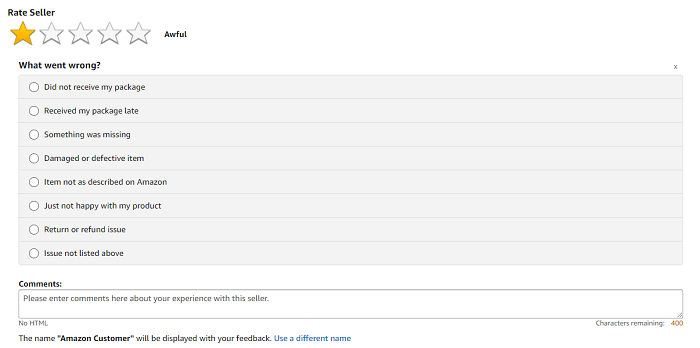
Amazon's customer satisfaction survey.
Drive consumers towards their goals with Talkwalker
Consumer journey mapping is an invaluable tool for every brand team and touchpoint – revealing exactly where you’re helping consumers move towards their goals, and where you’re not.
Talkwalker’s Social Listening software gives you insights into consumer behavior and sentiments at every stage of their journey – from awareness to action – by monitoring social media and web mentions.
Find out exactly where potential customers are finding challenges with your brand, or even abandoning their journey, and use these insights to curate a faultless consumer experience.
Keep consumers hooked from the awareness stage, until they’re singing your praises to other potential buyers!



